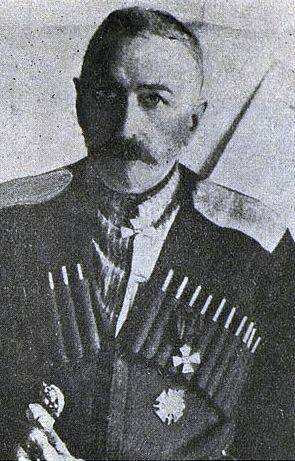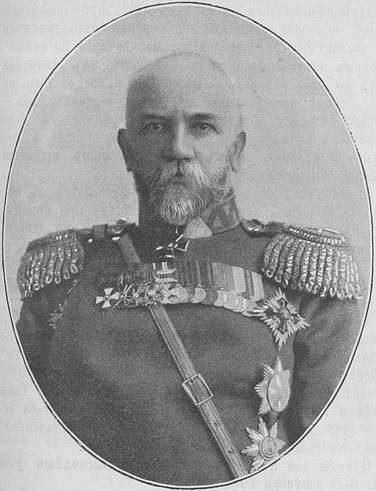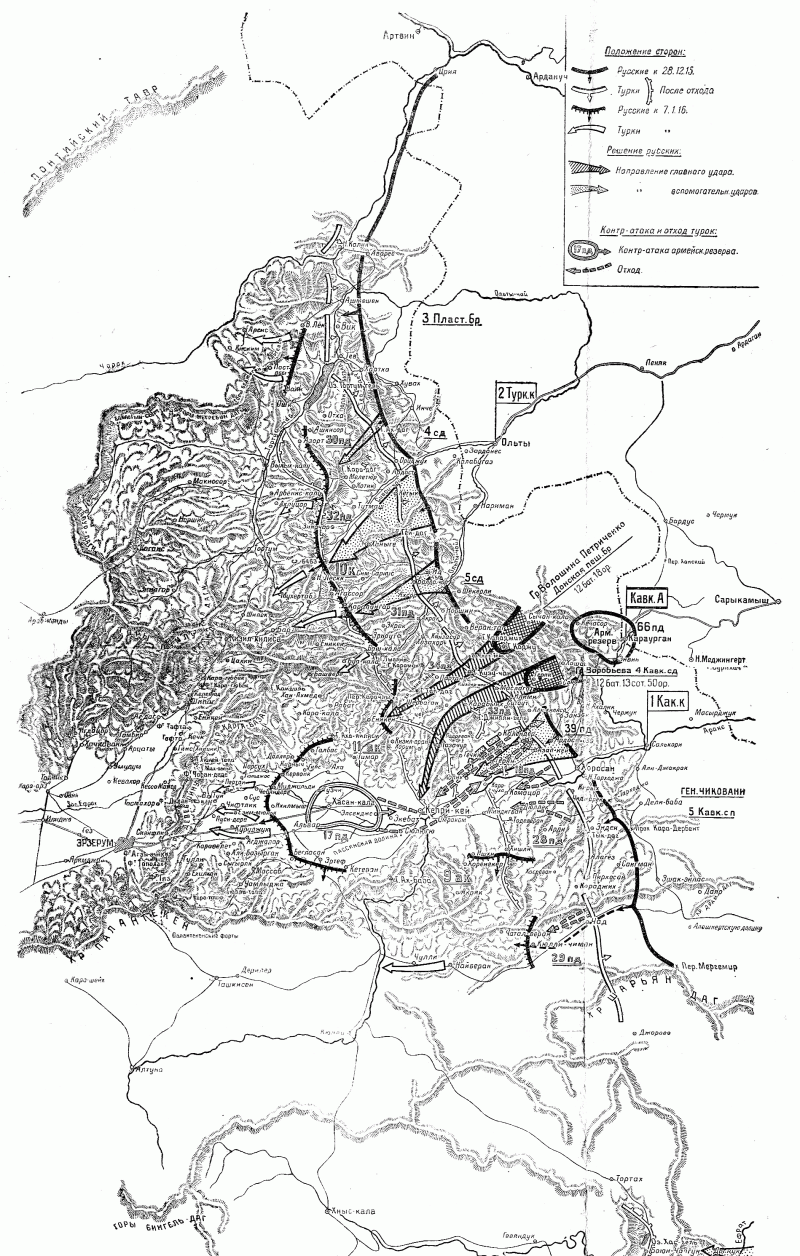Keprikeyskoe battle
The general idea of the offensive was to break through the center of the front of the Turkish army in the direction of the village of Kepri-kei. In order to attract the attention of the enemy, his reserves, as well as secretly concentrate troops of the army group to break through the front of the enemy, 2-th Turkestan and 1-th Caucasian corps had to launch an offensive a little earlier and in directions dangerous for the Turks.
The 2 th Turkestan Corps under the command of Przhevalsky was to go on the offensive in the area from the village of Hartha (east of Lake Tortum-gel, 30 km north-west of Olta) to s. Veran-tap At the first stage of the offensive, our troops were to occupy the gay knot of the mountain. Voloshin-Petrichenko’s special column (Donskaya foot brigade - 12 battalions, 18 guns) was supposed to seize Mount Kuzu Chan from the south and north and attack the mountains on Sherbagan, providing a strike group of the army from the right flank.
At the same time striking a column under the Vorobyov, a part of 4-th Caucasian Infantry Division and Siberian Cossack brigades and artillery (12 battalions, 13 hundreds, 50 guns, including 8 howitzers), I had to move from the area of the villages Sonamer and Geryak in the direction of Maslagat, Karabykh, Getchik, Kepri-Kay. Vorobyov's troops were to knock the Turks from their positions and advance into the flank and rear of the Turkish troops operating in the Passinskaya Valley in order to cut off their communication with Erzerum. The 1 Caucasian Corps under the command of Kalitina received the task of attacking at the Ilimi-Endek sector.
Offensive
2 th Turkestan building. 2 th Turkestan corps went on the 28 December 1915 offensive. The commander of the 2 corps decided to carry out the task of mastering the gay dag first of all with a mountain hub, not with a maneuver, but with a frontal blow. The terrain was extremely difficult to attack. An array of gay-dag mountains (up to 3 thousandths of meters) allowed an offensive only in the zone of its two peaks. The strongholds of the Russian and Turkish troops were located one against the other on two peaks of the gay-dag mountain, connected by a narrow isthmus, along which more than 12-15 could not be walked to people nearby. The sides of the isthmus, as well as the peaks, fell steeply into the gorge to a depth of 1 km. Because of the terrain conditions, it was possible to destroy the enemy fortifications only with howitzers, but they could not let them down because of off-road.
As a result, the 5 offensive of the Russian battalions on the r. Sivri Chai, the mountain of gay dag did not lead to success, despite repeated frontal attacks by enemy strongholds in this area and especially on the top of the mountain of gay dag. Only a successful offensive on the left flank of the 5 corps of the rifle division and the beginning of the breakthrough of the Turkish front in the Sarykamysh direction, led to the fact that on January 4 1916, the troops of the 10 Turkish corps began to retreat and on January 5 our troops occupied the gay dag .
On the 5 division of the rifle division, which received the task of capturing the heights near the village of Norshin, the offensive of the Russian troops, which began on December 28, ended successfully on January 3. Success was achieved as a result of the choice of a more favorable for the advance of the mountainous terrain, on which there were paths, and also thanks to the attack of the neighbors - the Voloshin-Petrichenko column. Having occupied the area of Karaman Mountain, the left flank of the Przhevalsky corps, in connection with the release of the 1 of the Caucasian Corps and the strike group of the army in the area with. Kepri-key, and parts of the Voloshin-Petrichenko column towards the Karacly pass, turned to the west. Attacking the Bar, the troops of the 2 of the Turkestan Corps threatened the flank and rear of the parts of the 10 of the Turkish Corps, which systematically retreated to the position of Kizil-Kilis, which closed the way to the Gurdji-Bogaz passage leading to the Erzerum plain.
The offensive went slowly because of inaccessible mountainous and roadless terrain, and the stubborn resistance of the troops of the 10 Turkish corps. On January 7, our troops captured passes on the Sivri-Dag ridge near the village of N. Leska. This was the most serious obstacle in the advance to Erzurum. On January 9, parts of the corps seized the position of the Turks at Kizil-Kilis, and on January 12 came to the fortification of Kara-Gübek, located in the Gurdji-Bogas aisle.

Commander of 2 of the Turkestan Army Corps, Mikhail Alekseevich Przhevalsky
Sarykamysh direction
Early in the morning of December 30, 1915 began an offensive on the Sarykamysh direction. The 1 Caucasus Corps Kalitina launched an offensive on the Ali Kilis-Endek sector. The army reserve was concentrated in the area of the villages of Karaurgan, Kechasor and Zivin. The offensive developed difficult and with great losses. The Turks relied on strong border fortifications and fought hard. They shot the terrain well and even switched to counterattacks. A particularly fierce battle followed the Azap-Kei position, where the best and shortest route to Erzerum was.
In addition, fearing for this sector of the front, which was rapidly attacked by the reinforced 39 th infantry division, the Turkish command concentrated its reserves in this direction. Our troops suffered huge losses in frontal attacks. However, Yudenich demanded that Kalitin continue his attacks. On December 31, Turkish troops, rejecting the right flank of the 39 Division, which was advancing on the position of Mount Gilli-Gel, themselves launched a counterstrike. The Turks hit the junction of the 39 Division and the 4 Division (Army Strike Group), trying to reach our flanks. However, this dangerous blow to the Turkish army was fended off by our reserves.
The Voloshin-Petrichenko column with great difficulty overcame, with the resistance of small parts of the Turks, the snow-covered spurs of the Chakhir-Baba mountain range. The commanders of the shock groups repeatedly asked Yudenich for reinforcement in order to break the resistance of the Turks. However, the army commander in all reports on the gravity of the situation and on the reinforcement of exhausted units invariably continued to demand an increase in the offensive, regardless of the losses. As a result, the 1-Caucasian troops quickly melted, but all the reserves of the Turkish army also quickly ended.
Thus, the advance of our army developed slowly due to the fierce resistance of the enemy, who occupied well-fortified positions and difficulties of the terrain. Russian troops, especially part of the 39-th division (lost up to half of its composition), suffered heavy losses. However, the Turks had exhausted their reserves and decided that it was in the 39 division of the division that Yudenich’s army dealt the main blow.
By the evening of December 31, Russian intelligence discovered that almost all Turkish units that were listed as Russians in the 3 Turkish reserve were put into the first line by the Turks. Then Yudenich reinforced from the army reserve 4-th rifle division 263-m. the Gunibsky infantry regiment, and the 1 Caucasian Corps, the Grozny 262 infantry regiment, ordered 1 to go over to all units on the night of January 1916 in a decisive offensive.
The offensive of the Caucasian army proceeded slowly due to the beginning blizzard, the complexity of the mountain conditions and the resistance of the enemy. However, on the night of the New Year, into a blizzard and a blizzard, the 4-I Caucasian Division broke through the front of the enemy. The Turkish command, distracted by the desperate attacks of the 39 division, left without proper attention the Sonamer, Ilimi, Maslagat and Kocut mountains without proper attention. In addition, there was a lot of rugged, wilderness, covered with deep snow, which was considered practically impassable. 4-I Caucasian Rifle Division occupied the area and in the evening went to the area of the village Karabyh. January 2 division completed the breakthrough of the Turkish front. And the Voloshin-Petrichenko column, capturing the commanding altitude - the city of Kuzu-chan, developed an offensive along the ridge in the direction of the Karachly Pass.
As soon as a breakthrough of the enemy front was designated, the army headquarters sent a Siberian Cossack brigade to it on the night of January 3, which received a special task - to blow up the bridge on the r. Araks y Kepri-key. The liquidation of this crossing led to the division of the Turkish troops, who were on both sides of the Araks, and the Turkish group, which was south of the river, was cut off from the best and shortest paths to Erzerum. However, the Cossacks got lost at night in the mountains in the conditions of a snowstorm and were forced to return without solving the problem. Later it turned out that the Cossack brigade was almost at the goal, but lost its way and turned back.
3 January 4-I Caucasian division, deepening the breakthrough, was advancing from s. Karabykhs in the flank and rear of the Turkish group of troops fighting against the 1 of the Caucasian Corps. Meanwhile, the troops of the Kalitin Corps, opposing the enemy, occupied the area of the village Kaland. The Turkish command, using all its reserves to contain the Kalitin corps, could no longer stop the advance of the army strike group and, on the night of January 4, began a rapid withdrawal of troops. Our troops did not notice the retreat of the enemy in time, and the Turks were able to come off for a while and avoided encirclement.
On January 4, units of the 4-th Caucasian Division were occupied by Kepri-kei, the Voloshin-Petrichenko detachment approached the Karachly Pass on the way to Hasan-Kala. The troops of the 1 Caucasian Corps, pursuing the fleeing Turks, also came to Kepri-Kay. On the southern bank of the river. Araks Turks also retreated, leaving their artillery depots and stocks. Thus, our troops broke through the center of the Turkish front, defeated the Sarikamysh group of the enemy. However, we did not succeed in destroying the main forces of the Turkish army in the Passinskaya Valley because of the skillful separation of the Turks at night from the 1 Caucasian Corps and the rapid escape from the possible "boiler" that created the 4 Caucasian division maneuver.
January 5 The Siberian Cossack brigade with the 3 Black Sea Cossack regiment was already conducting reconnaissance at Hasan-Kala. On January 6, our cavalry attacked the Turkish rearguard near this city, and then pursued the Turks almost in the dark to the advanced fortifications of Erzerum, built on the Debeboyna ridge. On the same day, the advanced units of the 1 of the Caucasian Corps occupied the area of the city of Hasan-Kala. January 7 The 4-I Caucasian Rifle Division and the 263-th Gunibsky Regiment advanced to the position on Deboin.

The commander of the 1 Caucasian Army Corps Peter Petrovich Kalitin
Results of the first stage of the operation
Thus, on January 7, the troops of the 1 Caucasian Corps, with their vanguards, have already reached the belt of the forts of Erzerum fortress. At this time, the 2 th Turkestan Corps was significantly behind, lingering before the strong mountain positions in the Kizil-Kilis region, occupied by the less frustrated Turkish 10.
Our losses in the 8-day battle were about 20 thousand people. The 39 Infantry Division lost up to half its composition. The 154 Derbent Regiment during the assault Azap-Kay lost all staff officers and led the regimental priest, Protopop Smirnov, who lost his leg during the assault. The Turkish army lost up to 25 thousand people and 7 thousand people were captured.
The main goal set by the commander of the army of Yudenich is to deliver a short, powerful blow in the direction of the sec. Kepri-kei, were achieved. 3-I Turkish army suffered a heavy defeat, losing powerful border positions. The main forces of the Turkish army were defeated in the Sarykamysh-Erzerum direction - the 9 and 11 corps. The intermingled Turkish units rolled back to Erzerum, not trying to gain a foothold in intermediate positions. The unexpected defeat caused extremely serious consequences: large losses in personnel and materiel (loss of warehouses with ammunition and food), which could not be replenished in the near future; the loss of winterized fortified positions, on which the Turks worked for a considerable time; moral disorder of the Turkish troops. However, the Russian troops failed to surround the Sarikamysh grouping of the enemy and completely destroy it, the Turks settled in Erzerum and waited for reinforcements. A halt to the offensive could have led to the restoration of the Turkish 3.
Yudenich informed the commander-in-chief of the Caucasus: “I am sure that the Turkish army is completely upset, demoralized, lost the ability to field battle, runs under the protection of the fortress. Warehouses are burning. Such a strong, fortified position, as Kepri-keyskaya, thrown without a fight. The complete conviction that an immediate assault on Erzerum can be successful, but a small number of rifle ammunition in warehouses does not allow me to decide on an assault. ”
Our troops rushed forward. General Yudenich, seeing this and knowing that the offensive impulse, decided immediately to begin the assault on the Erzerum fortified area. However, this operation - the storming of the strongest fortress, which the Ottomans considered impregnable, in a harsh winter, without siege artillery and a shortage of ammunition, demanded extraordinary strength of mind from the commander and the sacrificial heroism of the troops. Yudenich was ready to attack, as were the troops. Yudenich asked for permission from the commander-in-chief to take 8 million gun ammunition necessary for the upcoming assault from the reserve located far in the rear of the fortress of Kars. Thus, the storming of the Erzurum fortress was made dependent on the possibility of replenishing the consumed ammunition from the intact artillery depots of the Kars fortress.
But the Grand Duke Nikolai Nikolayevich and his entourage did not believe in the success of the assault. As noted by the military historian A. A. Kersnovsky: “By putting, like their ideal Moltke, the materialistic principle at the head of the strategy and completely neglecting the spiritual side, they strongly opposed the Erzurum operation”. The commander-in-chief ordered to withdraw the troops from Erzerum and Khasan-Kala and occupy the line of the Karacly Pass, p. Kepri-Kay, Ax-Baba Mountain (south of Kepri-Kay), creating a strong defense there.
Nikolai Nikolayevich wrote to Yudenich that “the general situation does not allow us to decide to move to the storming of Erzerum without careful preparation and with all the weapons necessary for this. In addition to the small number of rifle cartridges, we do not have the appropriate artillery to successfully combat the heavy Turkish artillery, forts and long-term fortifications; our general reserve is comparatively weak, our base is remote, and the supply, as you yourself have told me, further Kepri-keya is very difficult. Turks, judging by your reports, still offer serious resistance in front of the Turkestan corps. ... Maybe the Turkish army is not in a position to resist us in the field at this time, but we do not know what it is capable of at the fortress, with the support of hundreds of guns. In view of the above, I do not consider myself entitled to authorize the production of this operation. Use the most widely cavalry, if there is feed, for reconnaissance. ” Thus, the troops were going to take back and get to the winter apartment.
Yudenich insisted, but the commander-in-chief of the Caucasian front, being far from the troops, in Tiflis, categorically forbade the army commander to prepare for the assault on Erzerum. At the same time, it was repeatedly ordered to immediately stop further pursuit of the enemy, to stop the main forces of the army operating on the Sarykamysh direction, on the Kepri-Kay mountain lines, where to overwinter.
Yudenich, having received new data on the situation at the front, on the disorder of the Turkish army, for the last time resolutely requested by telephone from the Grand Duke permission to continue the offensive, stating that he was ready to assume full responsibility. As a result, Nikolai Nikolayevich yielded, stating that he disclaims responsibility for everything that could happen.
In the meantime, the command of the Turkish army 3 turned to Constantinople with a request to send reinforcements, which should have arrived in 20 days, otherwise it is not possible to keep Erzerum by those who have forces. This message was a complete surprise to the highest Turkish command. In Constantinople they decided to strengthen the 3 th army of the 50-th. soldiers who began to move from other theaters of war.
To be continued ...

Information